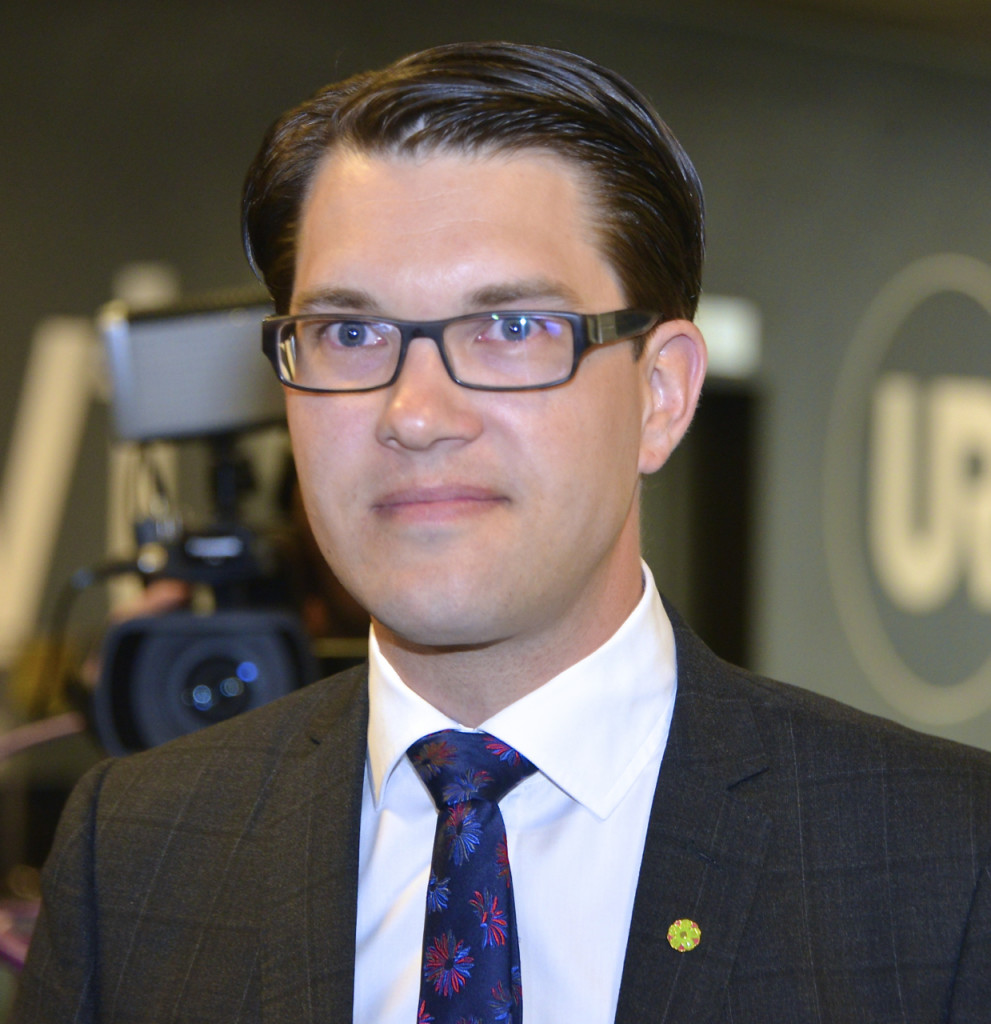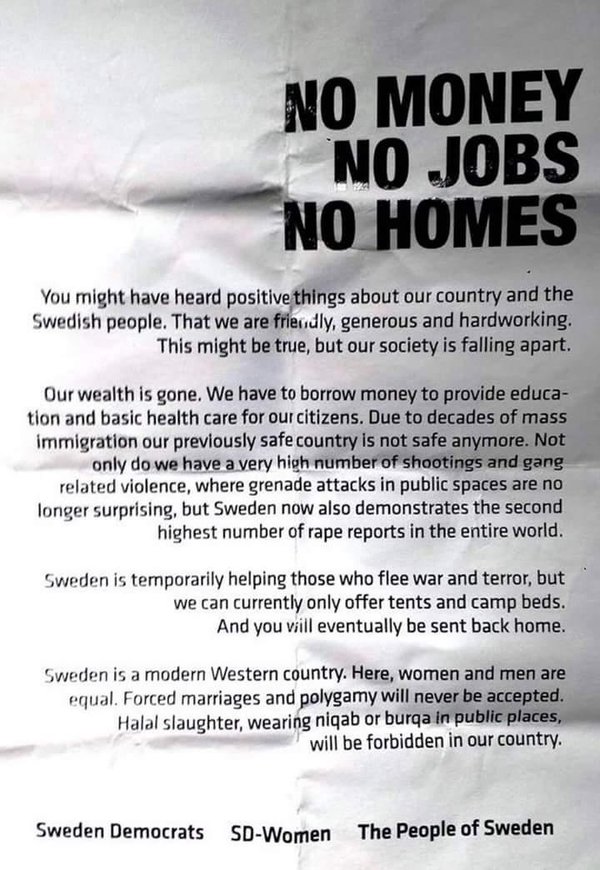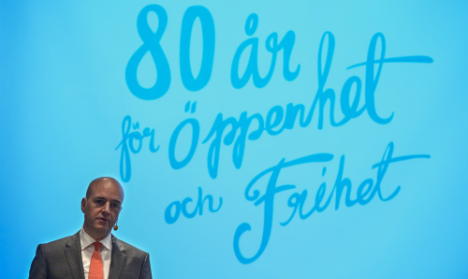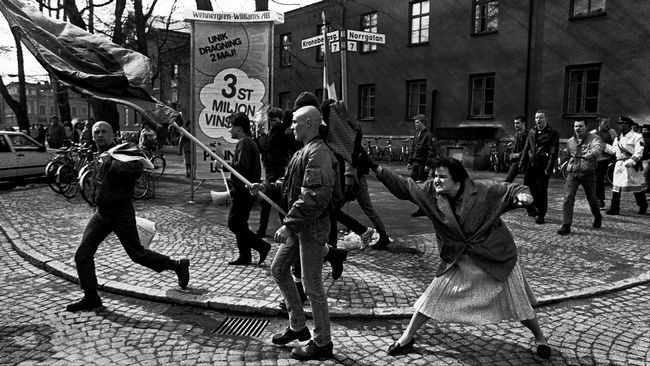A Year After Swedish Elections[i]: How Has the Country Changed?
It has been already more than a year when Sweden hold elections which divided Swedish Parliament “Riksdag” into three major parts and it has been a year when government decided to cancel snap elections[ii] and instead solve the parliamentary crisis by signing so called December Agreement valid for next eight years preventing another budget crisis. And it is also going to be a year, since Sweden started to face the biggest wave of immigrants in its history[iii], which divided not only Riksdag itself, but also Swedish society. And one more anniversary: it has been a year when Sweden passed the law strengthening hate speech prosecution[iv]. Within the year, the most controversial political party, Sweden Democrats, being perceived as radical far-right party, is growing in popularity. Putting all these indicators together, shall we say that we are witnessing new Sweden?
Sweden has always been a country known for its open door policy towards immigration and it is also crystal clear that the leading figures of Swedish Riksdag, primarily ruling Social Democrats and Green Party, would like to hold this status as long as the country can handle it (Fredlund-Blomst 2014; Migrationsverket History, n.d.). Sweden Democrats, which perceives itself as conservative with national ethos, gained 12,9% of votes a year ago meaning a huge success when we compare it to 2010 elections and 5,7% result (Election resources 2010; 2014). The party emerged from Swedish neo-Nazi roots (Lööw 2011), however its leader, Jimmie Åkesson, possess zero tolerance policy towards any far-right activities within members of the party and stresses that this is indeed a part of their history, however that the party is no longer on the same path and instead focuses on traditional values of Swedish society.
By the elections in September 2014, Social Democrats with 31 % of votes created government alongside Green Party. Whereas Moderate Party, on the second place, created the right-wing opposition with 23,3 % of votes (Election resources 2014). All parties refused to cooperate with the third largest party, Sweden Democrats and this decision still plays crucial role in current Swedish society.
Starting in December 2014, a newly elected Swedish parliament was about to vote for proposed budget, which later appeared as a start of crisis. The opposition blocked the negotiation by having its own proposed budget and Sweden Democrats hold resistant position claiming, that they will not vote for budget until the left-government will approve major changes in migrant policy (The Local 2014a). Let’s point out that at the end of 2014 year, Sweden faced 81, 301 requests for granting asylum (at the end of 2015, the number doubled); (Migrationsverket 2014, 2015); (The Local 2015a). The announced snap elections by Prime Minister Stefan Löfven were cancelled by the end of the year, when all parties besides Left Party and Sweden Democrats, signed an agreement valid until 2022 that the opposition will not bloc any budget voting in the future. This could be seen as ordinary government agreement; nevertheless, if we take a closer look, we might see the start of division of current Swedish society.

Social Democrats and Moderate Party had started to move themselves in direction which supports incoming immigrants, but which turned out in polls as step which took the votes away. During the last November days, they realized that the country is indeed incapable of accepting more refugees, thus they decided to launch emergency steps. After announcing the snap elections, Swedish media started to make number of polls to find out whether the atmosphere within Swedish society has changed and if there are some shifts in supports. As mentioned above, incoming immigrants seemed unstoppable and rhetoric of Social Democrats and Moderate Party supported the idea of accepting even more refugees. This understandingly divided the society and had side effect in the form of far-right sympathizers’ rise. Very surprisingly, Sweden Democrats were about to gain up to 18%, in contrary Social Democrats and Moderate Party preferences significantly dropped and the possibility of having Sweden Democrats on second place showed up as very probable (The Local 2014b). Therefore Moderate Party had stepped out of its opposition status and by signing the agreement prevented letting so called far-right party to co-rule.
It is also worth mentioning that by December 2014 a new law came into validity – easier prosecution of hate speech against immigrants (Selwyn 2014). This triggered opinions that the freedom of expression is no longer the case of Sweden. Indeed, several people were arrested for their hate speech on the internet (OSCE 2013). This law was suggested by Moderate Party politician Anders Norlén. On one hand, Sweden just joint several countries which already have this law to protect incoming refugees, on the other hand, many cases of implementing hate speech law were criticized by their Danish colleagues as repressing the freedom of speech (Brown 2015).
This was the momentum Sweden Democrats were waiting for. They strengthen their anti-immigration campaign during the immigration crisis that emerged mainly during summer 2015. When Europe was mostly shocked by enormous surge of refugees coming from Middle East, Sweden alongside with Germany showed the face of solidarity whereas the young members of Sweden Democrats started to give out leaflets at Greek island Lesbos titled „No money, no jobs, no homes“ aiming to discourage immigrants of trying to get to Sweden. The leaflet pointed out that incoming refugees are given only bed and basic hygienic needs, that Sweden already has not got enough working places, no money in social system and moreover increased number of violence and rapes (Mezzofiore 2015; Willits 2015).

By January 1st, 2015, around 4,900 of requests for asylum were recorded in Sweden. By May 1st , we are talking about 5,375 people, whereas only three months later, there are 11,746 of refugees and at the beginning of October, around 39,180 of requests. This is clearly more than 10 mil. country can handle and the prognosis for the end of 2015 year is 190,000 of requests in total. The offices accept around 7,000-10,000 requests per week, the capacities of accommodation facilities have already run out, additional camps are being built but it is still not enough. According to the statistics, the major group is from Syria tailored by Afghans. Taking a closer look to the incoming youth, 309 girls are among 7 to 12 years, around 902 between 16-17 years old, whereas boys in the first group 1,176 and in the second 10,761 (Migrationsverket 2015). Moreover, the frustration of Swedes has started to grown: according to the polls, in September 2015 around 44 % of Swedes thought that the country should welcome more immigrants comparing with 26% of Swedes in November. Another poll revealed that 41% of Swedes would welcome granted fewer residency permits for refugees – comparing with 29% in September (Euractive 2015).
Sweden increased its budget to help refugees integrate into Swedish society, but it is not enough to help all 190,000 refugees coming to the country within one year, to find jobs. Moreover, under the letter B paragraph in Convention and Protocol Relating to the Status of Refugees issuing the family reunion, most refugees are seeking their relatives already in Sweden (Convention 2010). It is known that major Swedish cities have theirs suburbs inhabited by immigrants[v].
In 2013, Swedish suburb experienced several days’ long riots in Stockholm’s Husby caused by police who shot man possessing a machete. The event launched violence in the streets caused by young immigrants complaining on the bad behaviour of police forces towards immigrants (Freeman 2013). Besides violence, the rapes statistics in Sweden also increased and the reports of rapes by immigrants are fulfilling tabloid first pages as well as bomb riots in Malmö (The Local 2015b); (Carlqvist and Hedegaard 2015).
Nevertheless the real problem lays in repressive attitude towards criticizing the open-door policy. In order to sustain ideas of solidarity over refugees, the country is affecting its own citizens. Not speaking about hate speech and hate crime laws, also every politician who publicly criticizes immigration policy of Sweden, becomes target of being marked as racist, xenophobic or neo-Nazis. This is one of the reasons, why Prime Minister defended the policy till the last breath; this is why Frederik Reinfeldt, former Moderate Party leader, came to the 2014 political campaign with motto: “open your heart to refugees, our country can absorb more than you think” (Crouch 2014).

Sweden Democrats built up their campaign on the topic which is the most sensitive in the country: immigration policy. They are pointing out on the rapes, violence, problematic suburbs, clash of religion, integration difficulties and so on[vi] (Carlqvist and Hedegaard 2015; The Local 2015b; Crouch 2015). Not even that this attitude divided the society, it also revived the dangerous phenomena of sympathizing with far-right.
First of all, Sweden Democrats are wrongly marked as far-right party in the common sense. According to their programme (SD Vår politik n.d.) and public behaviour including speeches, they in fact do not fulfil requirements to be marked as far-right[vii] (Counter Jihad 2015; Lööw 2015; SD Facebook profile). This misnomer is based on perceptions mentioned above: whoever is criticizing incoming immigrants, is automatically target of being racist. Starting in media, neither Swedish nor international media do not forget to put the attribute “far-right” before every mention of the party. Starting the articles by words “Sweden Democrats, the far-right party” automatically evoke the misleading feeling to perceive the party as radical far-right (see e.g. Greenwood 2015; Witte 2015). By emphasizing this term, it is undeniable attraction for real far-right sympathizers to be inspired by and to vote for. Yet, we cannot exclude the fact that indeed the party was founded by Leif Ericsson 1988, also co-founder of Bevara Sverige Svenskt, the far-right movement “Keep Sweden Swedish” (SD n.d.). So the party now founds itself a bit trapped into radical far-right history and conservative national position of today. Not so long ago, the party faced also several scandals with its members being caught in Nazis cloths, symbols or heiling (BBC 2014).
By the end of the October 2015, a young man (21), stepped to death Iraqi teacher and Somalian pupil in the school, where more than 90% of students are from immigrant families. Then he was shot by police (Malm and Joseph 2015). It showed up that the youngster supported Nazism and Sweden Democrats. This reveals us two sort of new phenomena turning around Sweden Democrats. Firstly, youngsters sympathizing with neo-Nazism have now clear election choice: Sweden Democrats. Secondly, the idea of anti-immigration policy attracts youngsters into the party, who might turn out in the future of being indeed radical far-right.
While having proven radical far-right supporter in the party would not have been very good business card for the party, having hidden radical far-right supporters may pose potential threat. Without debate, the situation in Sweden has worsened, in some cities or suburbs it become an open battlefield (The Economist 2013). Having some young immigrants men causing attacks, riots, violent, rapes cause part of the society paranoia of all the immigrants and on the other side due to the several arson attack to asylum centres, bomb and garnets explosions on the streets – paranoia among immigrants to be attacked by radical young Swedes.

Surely, the incoming number of immigrants is no longer bearable (Carqvist 2015). Nonetheless this situation is causing the rise of radical far-right youth movement. Speaking with leading representatives of Sweden Democrats, the editor of Guardian received the answers that these youth perceive immigrants as cultural threat and the only solution is something drastically needs to be done as the new political leadership in the country. Altogether with considering themselves as the new elite of the nation, one must think about clear radical far-right basis being born (The Guardian 2015).
The leader of Sweden Democrats, Jimmie Åkesson, seems to be conservative family type only wishing save Sweden to his children without any further ambition to rule the country (see e.g. his reaction to Paris attacks in Kassam 2015). This leads to the impression, that the leadership of Sweden Democrats really stick to its values declared on their website and wants only regulation of immigration flow. However, we cannot evaluate the party actions due to the not having anything to really evaluate. The party still remains in opposition and so far, it could be perceived only as populist far-right. The real question is: shouldn’t we take a closer look to the young Sweden Democrats in the meantime? Shouldn’t the leadership of the party watch out carefully their base in order not to raise real radical far-right supporters?
During late November 2015, Stefan Löfven announced that the controls at the Swedish borders are now in practise and will remain for some time. He also stressed that Sweden can no longer welcome all refugees: Sweden will be giving residence permits only to EU minimum level of refugees, the right for family reunification will be subject to a very strict time limit and children’s age will be strictly verified. Moreover, Prime Minister stressed that Sweden was naïve about potential of terrorist attack in the country and this should change (The Local 2015c). For part of the Swedish population, this was very shocking announcement and means sharp turn of open-door policy. The other half is a bit satisfied with at least something was done (Crouch 2015).
To conclude, I would like to point out that Sweden is a conservative country with open-minded society and first and fore more state of democratic values. And among those, we must also count the freedom of speech, the freedom of expression and the right to govern. By passing hate speech law and excluding the third major party out of ruling, it is not just stepped into democratic principles; it is also very thin ice to play on. Letting youngsters to radicalize have never brought anything favourable. Sweden Democrats might be the connecting element for radical far-right supporters, but it is in the first place the government, which decided to refuse listen to the other side of its inhabitants and let this situation happened. The way out? Instead of excluding Sweden Democrats, letting them co-rule – similarly what we can see in Denmark and its People’s Party. If the party is not banned by the state court, then it is not crossing the law, therefore it has the right to be heard and to make impression by its real actions and not by populism.
[i] September 14,2014 (Election resources 2014).
[ii] December 27, 2014 (The Local 2014b).
[iii] More than 150,000 requests during 2015 comparing with e.g. 31,819 in 2010 (Migrationsverket 2015, 2011).
[iv] The law taking full effect after Christmas 2014 (Selwyn 2014).
[v] Malmö citizens with foreign background increased since 2002 from 38,8% to 50,2% in 2015 (Sweden reports n.d.). The three major immigrants suburb in Sweden are: Husby (Stockholm), Angered (Göteborg) and Rosengård (Malmö). The number of immigrants there is around 80-86% (The Local 2012).
[vi] E.g. number of car fires in Sweden increased since 2000 from 756 to 1372 in 2015 (Sweden report n.d.).
[vii] In the report of Institute for Strategic Dialogue and Regeringskansliet Justidedepartementet „Preventing and Countering Far-Right Extremism“ author of chapter Sweden, Anders Ravik Jupskås, excluded Sweden Democrats from the article by stating, that despite that their roots lay in neo-Nazism, they succeeded in some extend to become populist radical right party instead (Jupskås 2011, 62). Moreover see Helene Lööw (2011, 275) and her note that Sverigedemokraterna (Sweden Democrats) is not xenophobic party in the generally understood sense.
Literature:
BBC. 2014. „Profile: Far-right Sweden Democrats.“ September 15. Accessed November 09, 2014. http://www.bbc.com/news/world-europe-29202793.
Brown, Andrew. 2015. „Copenhagen attacks: Scandinavians value free speech, but now they need to be practical.“ The Guardian, February 15. Accessed April 6, 2015. http://www.theguardian.com/commentisfree/2015/feb/15/copenhagen-attacks-scandinavians-free-speech.
Carqvist, Ingrid. 2015. „Sweden Close to Collapse.“ Gatestone Institute, October 17. Accessed December 21, 2015. http://www.gatestoneinstitute.org/6697/sweden-collapse.
Carlqvist, Ingrid and Hedegaard, Lars. 2015. „Rape Capital of the West.“ Gatestone Institute February 14. Accessed December 2, 2015. http://www.gatestoneinstitute.org/5195/sweden-rape.
Counter Jihad. 2015. „Presentation of Sweden Democrats.“ Accessed December 21, 2015. https://counterjihadeuropa.files.wordpress.com/2007/11/presentation-of-the-sweden-democrats.pdf.
Crouch, David. 2014. „The rise of the anti-immigrant Sweden Democrats: ‘We don’t feel at home any more, and it’s their fault’“. The Guardian, December 14. Accessed December 27, 2014. http://www.theguardian.com/world/2014/dec/14/sweden-democrats-flex-muscles-anti-immigrantkristianstad.
Election resources. 2010. “Sweden.” Accessed December 2, 2015. http://www.electionresources.org/se/riksdag.php?election=2010.
Election resources. 2014. “Sweden.” Accessed December 2, 2015. http://www.electionresources.org/se/riksdag.php?election=2014.
EU Times. 2014. „Sweden Passes Law That Will Prosecute People for Critizing Immigration.“ http://www.eutimes.net/2014/04/sweden-passes-law-that-will-prosecute-people-for-criticizing-immigration/.
Euractive. 2015. „Poll: Swedish support for refugees falls.“ November 9. Accessed December 21, 2015. http://www.euractiv.com/sections/justice-home-affairs/swedish-support-migrants-falls-poll-319318.
Freeman, Colin. 2013. „Stockholm riots leave Sweden’s dreams of perfect society up in smoke.“ The Telegraph May 25. Accessed December 2, 2015. http://www.telegraph.co.uk/news/worldnews/europe/sweden/10080320/Stockholm-riots-leave-Swedens-dreams-of-perfect-society-up-in-smoke.htm.
Fredlund-Blomst, Sofie. 2014. „Assessing Immigrant Integration in Sweden after the May 2013 Riots.“ Migration Policy Institute, January 16. Accessed December 21, 2015. http://www.migrationpolicy.org/article/assessing-immigrant-integration-sweden-after-may-2013-riots.
Greenwood, Phoebe. 2015. „Swedish asylum policy fuels support for far-right nationalist party.“ The Guardian, November 24. Accessed December 21, 2015. http://www.theguardian.com/world/2015/nov/24/swedish-asylum-support-far-right-nationalist-sweden-democrats.
Heléne, Lööw. 2011. „Sweden“. In Is Europe On The “Right” Path? Right-wing extremism and right-wing populism in Europe, edited by Langenbacher, Nora and Schellenberg, Britta. Berlin: Forum Berlin.
Jupskås, Aders Ravik. 2011. „Sweden“. In Preventing and Countering Far-Right Extremism: European Cooperation, edited by Sántha, Hanga and Ramalingam, Vidhya. Sweden: Institute for Strategic Dialogue and Regeringskansliet Justidedepartementet.
Kassam, Raheem. 2015. „Exclusive Interview: Sweden Democrats Leader Jimmie Åkesson Talks To Breitbart London From Brussels ‘No Go Zone’ Molenbeek.“ Breitbart, November 19. Accessed December 21, 2015. http://www.breitbart.com/london/2015/11/19/exclusive-interview-sweden-democrats-leader-jimmie-akesson-talks-to-breitbart-london-from-brussels-no-go-zone-molenbeek/.
Lööw, Heléne. 2015. „Jag trodde inte att nazismen skulle kunna återfödas i vår tid.” Dagens Nyheter, May 30. Accessed December 21, 2015. http://www.dn.se/kultur-noje/jag-trodde-inte-att-nazismen-skulle-kunna-aterfodas-i-var-tid/.
Malm, Sara and Joseph, Anthony. 2015. „Swedish school killer posed for this photo MIDWAY through murder spree: ‚Right-wing‘ fanatic put arm round pupil who thought bloody sword was a prank… then carried on his rampage.“ Daily Mail, October 22. Accessed December 2, 2015. http://www.dailymail.co.uk/news/article-3284339/Five-injured-sword-attack-Swedish-school-suspect-shot.html.
Mezzofiore, Gianluca. 2015. „Lesbos: Far-right Sweden Democrats distribute anti-refugee leaflets.“ International Business Times, November 9. Accessed December 2, 2015. http://www.ibtimes.co.uk/lesbos-far-right-sweden-democrats-distribute-anti-refugee-leaflets-1527907.
Migrationsverket. n.d. „History.“ Accessed December 21, 2015. http://www.migrationsverket.se/English/About-the-Migration-Agency/Facts-and-statistics-/Facts-on-migration/History.html.
Migrationsverket. 2011. „Asylum applications received.“ Accessed December 2, 2015. http://www.migrationsverket.se/download/18.5e83388f141c129ba63127ea/1381926423207/Inkomna+ans%C3%B6kningar+om+asyl+2010.pdf.
Migrationsverket. 2014. „Asylum applications received.“ Accessed December 2, 2015. http://www.migrationsverket.se/download/18.39a9cd9514a346077211b0a/1422893141926/Inkomna+ans%C3%B6kningar+om+asyl+2014+Applications+for+asylum+received+2014.pdf.
Migrationsverket. 2015. „Asylum applications received.“ Accessed December 2, 2015. http://www.migrationsverket.se/download/18.7c00d8e6143101d166d1aab/1448974429957/Inkomna+ans%C3%B6kningar+om+asyl+2015+Applications+for+asylum+received+2015.pdf.
OSCE. 2013. „Hate crimes Sweden.“ Accessed April 6, 2015. http://hatecrime.osce.org/sweden?year=2013.
Selwyn, Duke. 2014. „New Swedish Law Criminalizes Anti-immigration Internet Speech.“ The New American, April 23. Accessed Decmber 2, 2015. http://www.thenewamerican.com/world-news/europe/item/18116-new-swedish-law-criminalizes-anti-immigration-internet-speech.
Sverigedemokraterna. nedat. „Sverigedemokraternas historia; invandringspolitik .“ Accessed November 01. http://sverigedemokraterna.se/vart-parti/, http://sverigedemokraterna.se/varpolitik/invandringspolitik/.
Sverigedemokraterna. Facebook site. Accessed December 21, 2015. https://www.facebook.com/Sverigedemokraterna/.
Sverigedemokraterna. n.d. „Vår politik.“ Accessed December 21, 2015. https://sd.se/var-politik/.
Sweden reports. n.d. „Immigration.“ Accessed December 21, 2015. http://swedenreport.org/immigration-3/.
The Economist. 2013. „ Is the Intergation of Immigrants Failing?“ May 25. Accessed December 21, 2015. http://www.economist.com/blogs/charlemagne/2013/05/swedens-riots.
The Guardian. 2015. „Meet the Young Supporters of Sweden’s far right.“ Youtube, November 23. Accessed December 2, 2015. https://www.youtube.com/watch?v=A84b7qIxQMU.
The Local. 2012. „Another side of Malmö’s infamous Rosengård“. March 2. Accessed December 21, 2015. http://www.thelocal.se/20120302/39450.
The Local. 2014a. „Support for nationalists swells in Sweden.“ Accessed December 2, 2015. http://www.thelocal.se/20141208/swedes-more-negative-about-nationalist-party.
The Local. 2014b. „Sweden cancels snap election in March 2015“. December 27. Accessed December 29, 2014. http://www.thelocal.se/20141227/sweden-to-scrap-new-election-report.
The Local. 2015a. „Sweden split over move to tighten asylum rules.“ Accessed December 2, 2015. http://www.thelocal.se/20151124/sweden-set-to-tighten-asylum-rules-for-refugees.
The Local 2015b. „Third grenade attack in a week rocks Malmö.“ July 24. Accessed December 2, 2015.http://www.thelocal.se/20150724/third-grenade-attack-in-a-week-rocks-malm.
The Local. 2015c. „PM: Sweden has been ‚naive‘ about terror threat.“ November 19. Accessed December 2, 2015. http://www.thelocal.se/20151119/swedish-pm-country-naive-about-terror-threat.
UNHCR. 2010. Convention and Protocol Relating To the Status of Refugees. Accessed December 2, 2015. http://www.unhcr.org/3b66c2aa10.html.
Willits, Joseph. 2015. Twitter.
Witte, Griff. 2015. „Behind Sweden’s warm welcome for refugees, a backlash is brewing.“ The Washington Post, October 19. Accessed December 21, 2015. https://www.washingtonpost.com/world/europe/behind-swedens-warm-welcome-for-refugees-a-backlash-is-brewing/2015/10/17/b5f4110c-661d-11e5-bdb6-6861f4521205_story.html.





